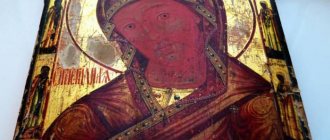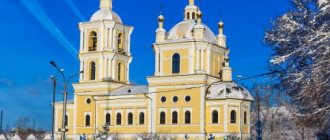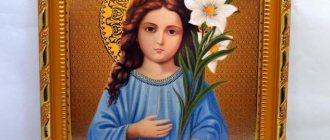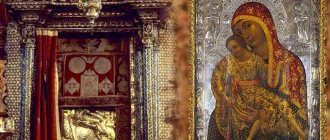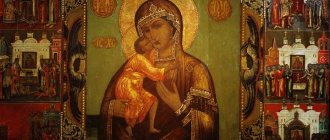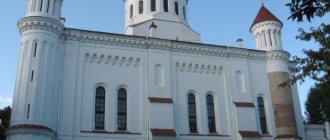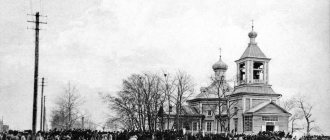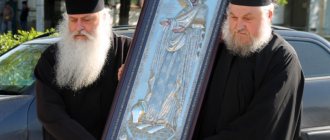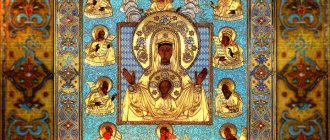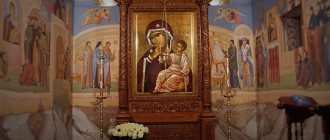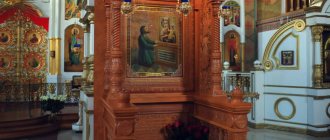The island of Valaam with its monastery has always been revered in Rus' as Northern Athos. It was especially glorified by the Saints Reverend Sergius and Herman of Valaam, who settled on the island in 1329 and founded the Transfiguration Monastery, whose icon and tomb attracted many pilgrims for many centuries.
One of them was Natalya Andreeva from St. Petersburg. Her amazing story laid the foundation for the worship of the miraculous Valaam Icon of the Mother of God.
History of appearance and acquisition
In the 19th century, a peasant woman, Natalya Andreeva, lived in St. Petersburg. The woman suffered from rheumatism. Doctors advised her to go to mineral springs for treatment. But the peasant woman had no money, and her illness constrained her more and more. One day, the Mother of God appeared to a woman in a dream and ordered her to find an icon in a monastery on the island of Valaam, on Lake Ladoga. The Virgin Mary promised that as soon as the peasant woman prayed in front of the image, the illness would go away.
First acquisition
Andreeva gathered her strength and went to Ladoga. To get to the monastery, we had to spend our last funds. The woman arrived on a special day. They began to build a new temple at the monastery. The altar was laid in the presence of the royal family.
A peasant woman prayed at the shrine containing the relics of the monastery’s founders. Already before her departure, the icon was found in the Assumption Church. The Mother of God appeared before the woman just as in the night vision - floating out of the golden haze, with the Eternal Child. Natalya was in a hurry to catch the ferry, so she quickly prayed and left. But at home she felt that the pain had subsided.
Before the appearance of the Mother of God, Andreeva could barely move, leaning on a stick. Returning from the trip, the woman began to walk freely, without support, but did not fully recover. Attacks of rheumatism still bothered me.
After some time, the peasant woman again went to pray to the miraculous icon, but the image disappeared. Andreeva pointed to the empty seat to the sacristan. He suggested that the icon was transported to the St. Petersburg chapel. But in St. Petersburg they did not receive shrines from the Ladoga monastery.
Second Finding
For the third time, the peasant woman came to the shore of the lake a year later, to celebrate the day of remembrance of the founders, Reverend Sergius and Herman. She again asked about the miraculous icon of the Mother of God, but it was never found. The upset pilgrim fervently prayed at the relics for the holy monks to help find her loss. And at night she saw a dream about a lost icon.
Natalya dreamed of the old St. Nicholas Church. An old man met her inside and asked why she was sad. Andreeva told him that she was looking for the icon of the Queen of Heaven, but even the sacristan was in ignorance and confusion.
The elder replied that the icon was in the temple, and the sacristan had poor memory. During an animated conversation, he led the woman to an inconspicuous door. Opening it, the stranger pointed to the icon. The image lay among church items.
Three more days passed. Again Natalya had a wonderful dream, as if she was in a temple, and next to her were two holy elders. And then a third young monk approaches them, accompanied by a sacristan. The guests brought a lost icon. A woman fell in a dream before the Mother of God. In the morning the woman went to church and learned that the image had been found. He actually lay among the utensils, in the place shown by the unfamiliar old man.
An unquenchable lamp was lit in front of the icon and the water was blessed. Andreeva washed the joints with holy water and anointed them with oil, also consecrated at the icon. The woman was finally healed. According to Natalya’s stories, the monastery assumed that Saint Nicholas appeared to her.
Where to hang
It is customary for Orthodox Christians to first purchase icons depicting Jesus Christ. A home iconostasis cannot be complete without a prayer cross and an icon of the Mother of God. All other faces of saints are chosen solely from personal preferences. The icon of the Valaam Mother of God is the protector and patroness of the female half of humanity. It serves as a reliable talisman for family ties and fidelity.
The icon depicting the Mother of God of Valaam does not have to be placed together with other faces in the home iconostasis. It can be placed in the bedroom, nursery, living room. It is necessary that the room is sufficiently spacious and bright. There is an opinion that icons cannot be hung in a room where there are no windows.
Fig. 4 The icon of Our Lady of Valaam can be placed either together with other faces of saints or separately. When offering prayers, you should always light a candle or lamp.
In ancient times, Christians tried to place the iconostasis in the easternmost corner of the house. After all, it is customary for Orthodox Christians to pray standing facing east. However, in modern conditions, you can ignore this rule and arrange church images at your own discretion.
Advice! The main rule that requires fulfillment is respectful respect for the faces of saints. Therefore, hanging the icon of Our Lady of Valaam is allowed in any clean and spacious room of the house.
Church relics can be placed on open shelves, chests of drawers, tables or glass cabinets. You cannot hammer nails directly into the canvas, as this will deteriorate the image quality and the icon will lose its value. It is recommended to place holy faces on openwork napkins or towels embroidered in folk or church style.
Icons cannot be placed:
- next to photographs of deceased relatives;
- near household and electronic equipment;
- along with idols, icons and other paraphernalia of a non-Orthodox religion;
- next to art paintings, books, souvenirs.
Important! A home iconostasis is not a church altar and it is not necessary to follow strict church canons. However, a neglectful attitude towards the Shrines, improper organization of space for prayers, can worsen the Orthodox aura and then all ascensions to the Heavenly patrons will remain in vain.
If the icon is located opposite a window, then as a result of constant exposure to sunlight, the colors may fade and the canvas may delaminate. To store handwritten and ancient relics, icon painting experts recommend placing them in special glass boxes called ketones. You can put a cross next to the Valaam face of the Mother of God. It is better to hang the lamp on a long chain from the ceiling.
Description and meaning in Orthodoxy
The Valaam icon was painted by Hieromonk Alipius, a professional icon painter with an artistic education. The author combined academic style and Athonite writing tradition. According to legend, the image was painted at a time when Natalya Andreeva fell ill.
Writing Features
The Virgin Mary of Valaam is depicted:
- on a cloud;
- dressed in a blue tunic and a red cape;
- with protruding bare feet.
The Eternal Child sits on the left hand of the Most Pure Virgin, and with her right She intercepts Him in front. Baby Jesus is dressed in a white tunic. In His left hand is an orb with a cross, and in His right hand He bestows a blessing. Red tones in icon painting symbolize royalty, blue - holiness, and white - purity of the soul.
The open feet of the Mother of God and the Savior holding the orb are characteristic features of the Valaam icon, not typical for Orthodox iconography.
The background is also painted in an unusual multi-layer technique, without traditional gilding. Therefore, the Most Pure Virgin looks spiritual and as if floating on a cloud. In general, the image resembles the type of Byzantine icon “Nicopea”. A parallel is also drawn with the shrine of Greek Athos - the Mother of God Abbess. Hidden inside the icon is a fragment of a robe that belonged to the Virgin Mary.
Value for believers
The Valaam icon is a symbol of the patronage and favor of the Mother of God towards the monastery and the Russian state. This is confirmed by the visions of the Ladoga elders, in which the Virgin Mary with tears begs the Lord to have mercy on the Russian state. The Virgin Mary, praying for Russia, appeared to the monks during the First World War.
The image is one of the three most revered icons, along with the Sovereign and Port Arthur icons. The discovery of the Valaam and Sovereign icons marked in turn the beginning and end of the reign of Nicholas II. After the seizure of power by the Bolsheviks and the eradication of religion, the shrine left the Russian soil - the Most Pure Virgin could not be among the blasphemers.
The Valaam Mother of God symbolizes monastic prayer and mental work. With Her help, the doubting brethren received confirmation that the sarcophagus in the main church contained the true relics of Saints Sergius and Herman. The monks suspected that the shrine was empty, and that the real grave was somewhere on the island.
One day, during prayer, one of the monks looked at the image of the Most Pure Virgin and saw on both sides of it the shining images of the holy founders. The vision also strengthened the brothers’ confidence that the monastery was under the protection of the Mother of God. After the discovery of the image of the Mother of God of Valaam, the monastery turned into the main place of pilgrimage for Russian believers.
Icon of the Valaam Mother of God
If we look into the area of iconography, we will see that the icon of the Mother of God from Valaam belongs to the “Panagia” - the Mother of God images. There is also a type of icon “Nicopeia”, with which a compositional relationship can be traced.
Icon of Our Lady of Valaam
When looking at the icon, pay attention to the bare feet of the Intercessor and the orb in the hands of Jesus. This is what distinguishes the icon of the Mother of God in Valaam from its analogues created in other Orthodox monasteries.
The history of the icon of the Valaam Mother of God
The author of the icon is the legendary hieromonk Alypius, who before being tonsured was trained as an artist. The hieromonk worked on the icon for a long time and completely completed the creation of the image in 1878.
Icon painter Hieromonk Alipiy (Konstantinov).
For unknown reasons, the Mother of God was not given a place on the iconostasis—the shrine had been gathering dust for 20 years in the monastery’s storeroom. Similar stories happened with other icons, but this case is special. Further events unfolded in the following sequence:
- Natalya Andreeva, a pilgrim with sore legs, went on a journey in search of healing icons.
- At night, the pilgrim had a dream with the Mother of God of Valaam - this happened in 1897.
- Some time later, the icon was discovered in the storeroom of an abandoned temple (Andreeva’s pilgrimage took about a year).
- In 1940, the island of Valaam became part of the USSR, and the monks transported the miraculous image to Finland - where New Valaam was founded.
- Now the shrine is considered the most important relic of the New Valaam Monastery.
If you are going to Valaam, it is worth considering that a copy of the famous icon is kept there (the original is still in Finland). Our compatriots began celebrating the day of the venerable image in 1997 - after the permission of Alexy II. In Finland, the date is different from Russia (celebrated on August 7th) - you need to know this about the icons before starting the prayer.
A new milestone in the history of the image was the year 2000 - it was then that Alexy II blessed the construction of a church erected in honor of the relic. The expected location of the image detection was chosen as the site. In 2005, the temple was solemnly consecrated, after which the doors opened to believers.
Description and meaning of the image of the Valaam Mother of God
Icon of the Mother of God “Valaam”.
Church of the Transfiguration Cathedral in honor of Saints Sergius and Herman of Valaam. The icon has a deep symbolic meaning. The parishioners met the Valaam Mother of God in the year when Nikolai Alexandrovich, the Russian Emperor, went through the wedding ceremony. Hence the majesty of the image, the red robes and the great-power meaning inherent in the icon.
Meek silence and patronage of mortals - this is what the Valaam icon represents.
It is worth noting that numerous healings serve as proof of the miraculousness of the icon. Even the blessed list attracts pilgrims flocking to Valaam from all over Russia. The last recorded miracle was the recovery of the son of a Greek clergyman. Archimandrite Sergius, rector of New Valaam, has evidence of this. So don’t despair and feel free to plan a pilgrimage if you have any health difficulties.
Where to find the original and revered lists
The first copy was made by Valaam craftsmen as a gift to Nicholas II. At the beginning of the 20th century, a second list appeared. It was kept in St. Petersburg, in the Valaam Chapel, and through prayers near it people began to be healed.
The miraculous icon was transferred from the chapel to the church at the Smolensk cemetery. Townspeople and numerous pilgrims came to venerate the shrine, and healings were again witnessed. Now the miraculous list is located on Valaam Island. In a special accounting book, the monks record cases of healing.
The original belongs to the Finnish New Valaam Monastery. The monks left the Soviet Union for a neighboring country to save the shrines of Valaam from the defeat of the atheistic government, and founded a new monastery.
In 1992, the Finnish Orthodox community donated a list to the monastery in Finland, slightly different from the original. Later he was transferred to the capital's Russian compound. Another image from 1997 is in the St. Petersburg Kazan Church of the Valaam courtyard.
Reverence
The Feast of the Valaam Icon of the Mother of God takes place annually in two countries. In the Russian monastery it is celebrated on the first Sunday after the day of remembrance of the apostles Peter and Paul. In the Finnish New Valaam monastery, the holiday date is set for August 20th.
The miraculously found shrine was revered in the royal family. Prince Nikolai Nikolaevich came to the Valaam Monastery to pray in front of the holy image. During the First World War, he donated money to the monastery to maintain an unquenchable fire in front of the icon. One of the healed parishioners donated funds for the painting of the temple consecrated in honor of the icon, the installation of an iconostasis and the writing of a copy.
On holidays, solemn services and water-blessing prayers are held in the churches of the Russian and Finnish monasteries. In 2017, the monasteries celebrated the anniversary - 120 years since the acquisition of the image.
What do they ask for before the image?
You can hope for the help of the Mother of God of Valaam in the following requests:
- strengthening faith;
- the gift of humility;
- liberation from despondency and sorrow;
- intercession from enemies.
The icon helps alleviate mental and physical ailments. The Valaam Mother of God patronizes people who carry out monastic obedience, as well as Russian martyred soldiers.
How to pray correctly in front of the Valaam icon of the Most Holy Theotokos
The rules of prayer to the miraculous Mother of God are not much different from general Orthodox regulations.
The icon of the Mother of God (with Valaam or other origin) helps those people who really need help. Ancient icons are a serious means of healing ailments. The more time you spend in front of such icons, the better (the images of the Valaam masters are no exception).
To achieve what you want through prayer, adhere to the following rules:
- Stand at the Valaam Icon with an open heart, do not be deceitful.
- Prayer should be pure, think about the Mother of God, and not about vain things.
- The church recommends placing candles in front of the icons; the mistress will like it.
- Please note that no one guarantees you heavenly intercession, be patient.
- Do not forget to ask the Mother of God for help in overcoming destructive passions.
- If you ask the Mother of God to heal a loved one, the likelihood of recovery increases.
- Before visiting the Valaam lands, confess.
- Do not forget to ask our God for healing the rest of the time.
- The Mother of God of Valaam helps only true believers - those who have already accepted Jesus into their hearts.
- Before any icons you need to cross yourself, ensuring the proper level of respect.
Texts of prayers
The troparion to the icon was written by Archbishop of the New Valaam Monastery Pavel Olmari. One of three prayers is addressed to the Mother of God.
First
To the Most Holy Lady, Lady Theotokos, our country's Intercessor, the monastery of Valaam, beauty and glory. Looking at Your most pure face, revealed in the miraculous icon, we pray to You: protect this monastery from all evil, which the venerable Sergius and Herman founded, protect and preserve peace among the brethren, protect its builders, benefactors and beautifiers with Your Protection. O Our All-Honorable Mother, Mother Superior of all Orthodox monasteries and monastic life, Patroness, remain constant from this monastery, Your present heritage, and cover us with Your omnipotent prayers and protect us, who labor here, from all troubles and needs, help us to preserve the statutes of the venerable fathers unshakably, deliver from the falls of sin, grant us the spirit of contrition and humility, instruct us in fulfilling monastic vows and all the commandments of God. Accept our humble prayer, warm us with the breath of Thy love and never depart from us, so that faith in us sinners may not become scarce, and may we be worthy to enter the Kingdom of Heaven, in which we will glorify You, our All-Singing Mother, and glorify Your Son and our God with His beginningless Father and His Most Holy and Life-giving Spirit, now and ever and unto ages of ages. Amen.
Second
O Most Holy and Most Blessed Lady Theotokos, Queen of heaven and earth, Patroness of the monastery of Valaam! We fall down and bow to You before Your miraculous icon, and as You mercifully regarded the prayer of Your sick servant and granted her healing, so now accept our fervent prayer offered to You. Save and preserve, O All-Merciful One, our Fatherland and all the Orthodox people living in it and running to You with love, from the invasion of foreigners, from famine and pestilence, and from all evil; direct our paths, may truth and peace, joy and love shine in the lands of Russia, preserve the Orthodox faith in it until the end of time. Look with Your merciful eye at the monastery of Valaam and accomplish in the Lord the salvation of all who labor in it in faith and hope. Pray to Your Son and our God, may He deliver us all from all troubles, sorrows and illnesses, may He instruct us to fulfill His commandments, may He deliver us from eternal torment, and may He grant us through Your intercession to dwell in the heavenly abodes and glorify there the Most Holy Trinity, the Father and the Son and the Holy One Spirit, now and ever and unto ages of ages. Amen.
Third
Oh, Wonderful and highest of all creatures, Queen Theotokos, Mother of the Heavenly King Christ our God! Hear us, Thy sinful and unworthy servants, at this hour praying and falling to You with sighs and tears and tenderly saying: lead us from the pit of passions, Lady, deliver us from all sorrow and sorrow, protect us from all misfortune and evil slander and from the unrighteous and the fierce slander of the enemy. May you, O Gracious Mother of God, not only save Your people from all evil, but also provide them with every good deed and save them, unless You have other Representatives in troubles and situations and warm Intercessors for us sinners, not Imams to Your Son, Christ our God . Pray to Him, Lady, that through Your salvation, we may glorify in the future the all-holy name of Your Son and our God, together with the Father and the Holy Spirit, now and to endless ages. Amen.
